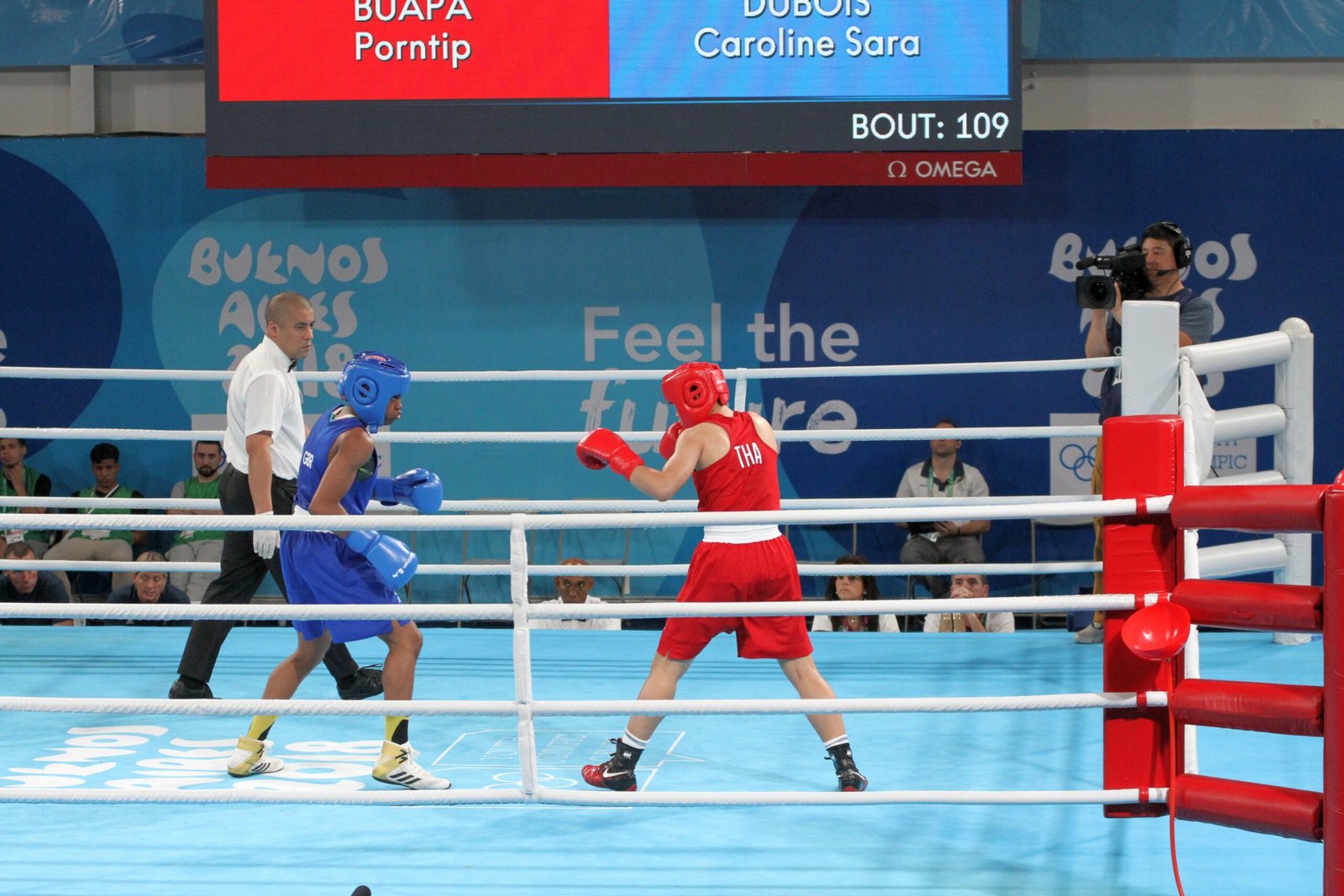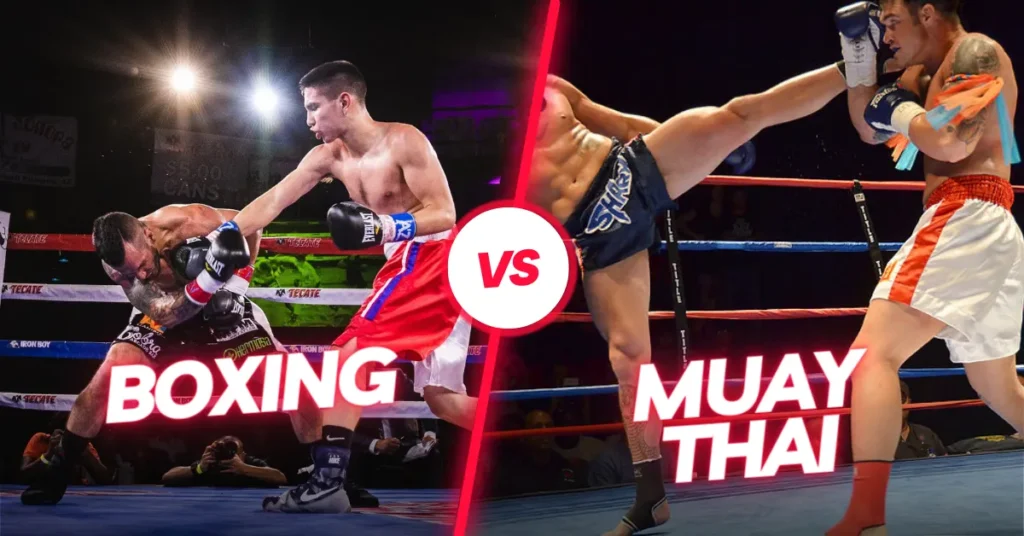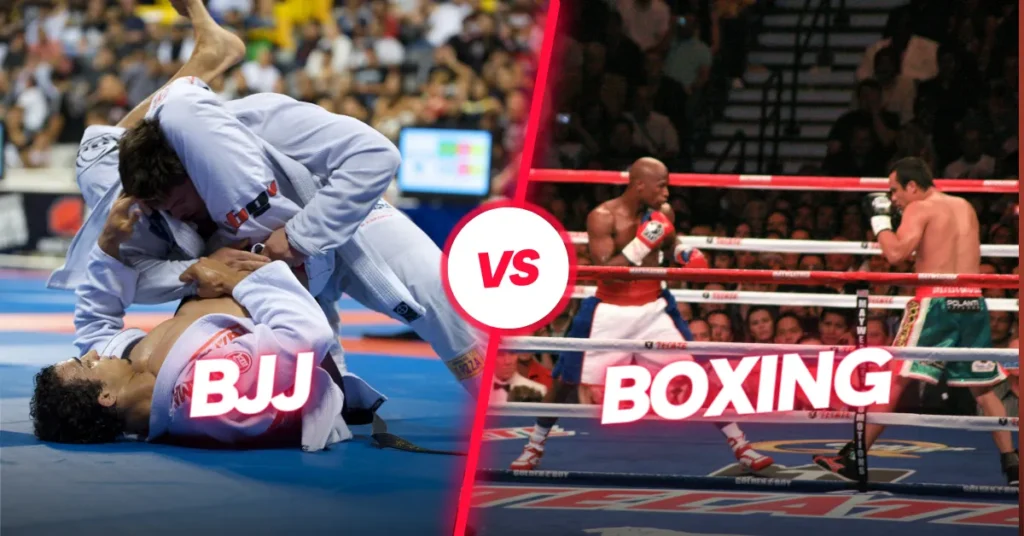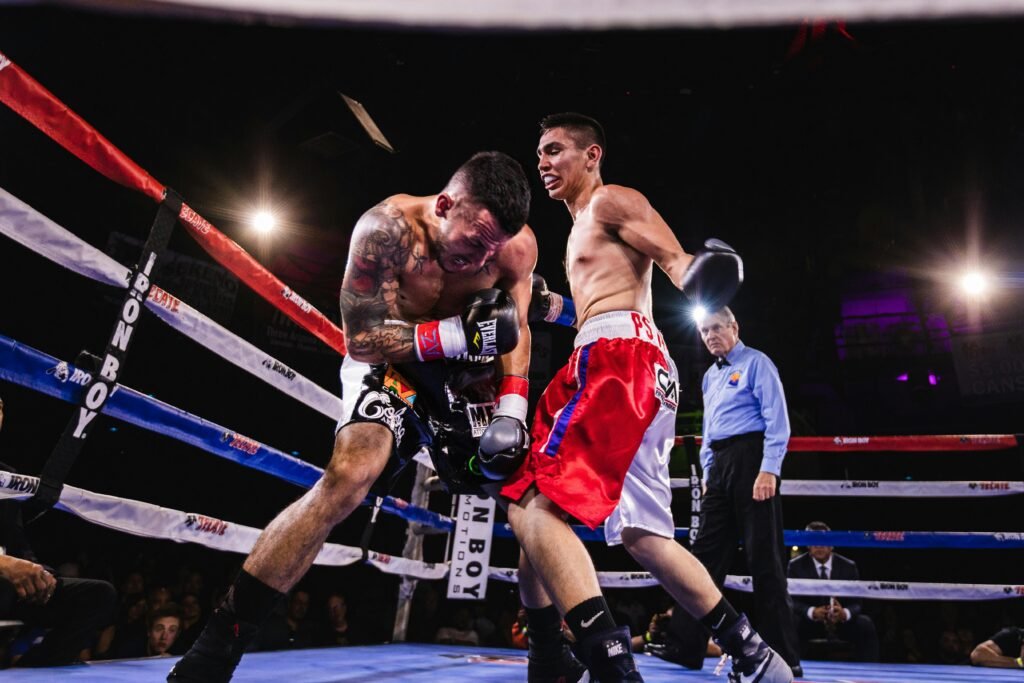If you’re new to combat sports and are wondering what the differences are between Muay Thai and western boxing, you’re not alone. In Muay Thai, fighters have more weapons at their disposal, including punches, kicks, knees, elbows, and clinch work. Boxing, on the other hand, focuses solely on punches. The stances and footwork are also different between the two sports, with Muay Thai favoring a more linear stance and boxing utilizing a bladed stance. Ultimately, the choice between boxing and Muay Thai depends on your personal goals and preferences.
Table of Contents
Key Takeaways
- Boxing focuses solely on punches, while Muay Thai incorporates punches, kicks, knees, elbows, and clinch work.
- Boxing utilizes a bladed stance, while Muay Thai favors a more linear stance.
- Personal goals and preferences should drive the choice between boxing and Muay Thai.
- Both sports require dedicated training to develop effective striking skills.
- Muay Thai offers more versatility in terms of offensive and defensive techniques.
The Weapons in Muay Thai and Boxing
In the realm of combat sports, Muay Thai and boxing stand out as two striking arts that captivate audiences worldwide. While both disciplines share the common goal of defeating opponents, they differ significantly in terms of the weapons each allows. Understanding these differences can help practitioners and enthusiasts appreciate the unique aspects of each martial art form.
The first distinction between Muay Thai and boxing lies in the range of weapons available to fighters. Muay Thai, often hailed as the “art of eight limbs,” grants practitioners a diverse array of attacking techniques. Fighters can utilize punches, kicks, knees, and elbows to devastate their adversaries. The incorporation of clinch work in Muay Thai further enhances its arsenal, enabling practitioners to strike and throw opponents from close range.
On the other hand, boxing emphasizes the art of punches. In this discipline, fighters are limited to using only their fists as weapons both from the outside and the inside. The focus on honing punching techniques, combinations, and defensive maneuvers distinguishes boxing as the “sweet science.” However, clinching in boxing is diligently separated by the referee, emphasizing the sheer boxing skill and strategy employed by its practitioners.
Muay Thai’s broader range of weapons sets it apart as the “king of striking arts.” With its emphasis on not just punches but also kicks, knees, elbows, and clinch work, Muay Thai fighters possess a more comprehensive toolkit for combat. This versatility adds layers of complexity to the art form, demanding a deep understanding of timing, distance, and strategy.
In Muay Thai, every part of the body becomes a weapon, allowing fighters to unleash devastating attacks from all angles and distances.
Furthermore, Muay Thai’s rich heritage and cultural significance have elevated it to a revered status among striking arts. The marriage of power, technique, and grace in Muay Thai strikes resonates with enthusiasts, making it a profound experience both in training and competition.
While boxing remains an esteemed discipline in its own right, its focus on punching techniques and defensive strategies encapsulates the essence of the “noble art.” Boxing’s simplicity and precision have earned it a prominent place in the combat sports world, producing legendary pugilists renowned for their exceptional skill and agility.
In summary, Muay Thai and boxing offer distinct approaches to striking arts, each with its own set of weapons and strategies. Muay Thai’s wide range of attacking techniques, including punches, kicks, knees, elbows, and clinch work, contributes to its reputation as the “king of striking arts.” On the other hand, boxing’s emphasis on refined punching techniques and defensive maneuvers solidifies its standing as the “sweet science.” Ultimately, the choice between the two depends on personal preferences, training goals, and the desire to master specific techniques and strategies.
Learn more about Muay Thai: What Is Muay Thai?
Punching Mechanics in Boxing and Muay Thai
Boxing is renowned for producing some of the best punchers in the world. Boxers focus solely on perfecting their punching techniques, which results in clean and powerful punches. Muay Thai, a striking art that incorporates boxing, also emphasizes punches. However, the punching mechanics in Muay Thai differ from traditional boxing.
In boxing, practitioners dedicate their training to mastering the art of clean punching techniques. They focus on generating power, accuracy, and speed in their punches. Boxers often employ various punches such as jabs, crosses, hooks, and uppercuts, training their bodies to deliver impactful blows.
On the other hand, Muay Thai fighters harness a wider range of striking techniques beyond punches alone. While their punching mechanics may not be as refined as those of boxers since they follow up punches with kicks, knees, and elbows, their strikes still carry significant power. Muay Thai fighters strategically blend punches with other striking techniques to create a fluid and versatile offensive approach.
Both boxing and Muay Thai require extensive training to develop effective striking skills. However, boxers inherently specialize in punching mechanics, delivering clean and powerful punches, while Muay Thai fighters employ a more diverse arsenal of strikes. Each style offers unique advantages and considerations, allowing practitioners to choose the approach that aligns with their preferences and goals.
| Punching Mechanics | Boxing | Muay Thai |
|---|---|---|
| Focus | Exclusively on perfecting punches | Emphasizes punches while incorporating other strikes |
| Techniques | Jabs, crosses, hooks, uppercuts | Punches, kicks, knees, elbows |
| Training | Specialized in delivering clean and powerful punches | Integration of punches with a wider range of strikes |
Attacking Rhythm in Muay Thai and Boxing
The attacking rhythm in Muay Thai and boxing varies due to the diverse range of weapons employed in each sport. Boxing relies on steady rhythms, with fighters executing combinations of punches, including jabs, straights, hooks, and uppercuts.
Muay Thai, on the other hand, incorporates broken rhythms, where fighters introduce pauses between strikes and integrate kicks and elbows into their combinations. This unique style allows Muay Thai practitioners to surprise opponents with unexpected strikes and disorient their defensive strategies.
“The best way to approach a fight is by varying your rhythm. Sometimes you need to push the pace and attack with rapid combinations, while other times, you’ll want to pause momentarily to disrupt your opponent’s timing and catch them off guard.”
Boxing’s association with “punches in bunches” highlights the rhythmic nature of boxing attacks, where fighters unleash rapid and continuous punches to overwhelm their opponents and create openings for powerful strikes.
In contrast, Muay Thai fighters strategically mix up their rhythm, breaking the predictability of their attacks and incorporating fluid transitions between punches, kicks, knees, and elbows. This dynamic and unpredictable rhythm allows them to exploit vulnerabilities and maximize the effectiveness of their strikes.
Comparing Attacking Rhythms
| Muay Thai | Boxing |
|---|---|
| Utilizes broken rhythms | Uses steady rhythms |
| Pauses between strikes | Throws rapid combinations |
| Integrates kicks and elbows into combinations | Focuses on punches |
| Exploits unpredictability to create openings | Overwhelms opponents with continuous punches |
Learn more about Boxing: What is Boxing? History, Rules, Weight Divisions.
Head Movement in Boxing and Muay Thai
Head movement plays a vital role in the defensive strategies employed in both boxing and Muay Thai. Boxers have the advantage of utilizing head movement to evade punches, slip strikes, and duck under attacks, showcasing their defensive prowess. They can freely bob and weave, making it difficult for opponents to land clean punches.
In contrast, head movement in Muay Thai requires a cautious approach. While fighters do incorporate some head movement, excessive movement can be risky due to the threat of elbows, kicks, and knees. Muay Thai fighters primarily focus on upper body movement to evade kicks and punches, allowing them to navigate the clinch and implement defensive strategies effectively.
“Head movement is the key to avoiding direct hits and minimizing damage in both boxing and Muay Thai. While boxers have mastered the art of slipping punches, Muay Thai fighters must strike a delicate balance between evading strikes and countering effectively.”
Both boxing and Muay Thai emphasize the importance of defense to avoid taking unnecessary damage during a fight. While head movement is an essential aspect of defensive strategies in both sports, the techniques and approaches vary due to the different range of strikes and techniques employed.
Now let’s take a look at a comparison table that highlights the key differences in head movement between boxing and Muay Thai:
| Boxing | Muay Thai |
|---|---|
| Utilizes head movement to evade punches and slip strikes | Focuses on upper body movement to evade kicks and punches |
| Allows fighters to freely bob and weave, showcasing defensive agility | Requires cautious head movement due to the threat of elbows, kicks, and knees |
| Enables boxers to minimize damage by avoiding direct hits | Strikes a balance between evading strikes and countering effectively |
Muay Thai’s Versatility Compared to Boxing
Muay Thai is renowned for its versatility, offering a wide range of offensive and defensive techniques that make it a well-rounded striking art. Unlike boxing, which primarily focuses on punches, Muay Thai incorporates a variety of strikes and techniques, enhancing its effectiveness in combat.
Here is a breakdown of the key differences between Muay Thai and boxing:
Strikes
In Muay Thai, fighters have a vast arsenal of strikes at their disposal, including punches, kicks, knees, and elbows. This versatility allows them to adapt to different scenarios and create a more dynamic offense. On the other hand, boxing focuses solely on punches, honing the art of delivering powerful and precise strikes with the fists.
Grappling and Clinch Work
One of the distinctive aspects of Muay Thai is its incorporation of clinch work, which involves close-range fighting, controlling the opponent’s movements, and utilizing a combination of strikes and throws. This grappling aspect adds another layer of versatility to Muay Thai that is absent in boxing, which primarily focuses on striking from a distance.
Comparison of Versatility in Muay Thai and Boxing
| Muay Thai | Boxing | |
|---|---|---|
| Strikes | Includes punches, kicks, knees, and elbows | Primarily focuses on punches |
| Grappling and Clinch Work | Utilizes clinch work for close-range fighting | Does not incorporate grappling or clinch work |
Differences in Stances and Angles
The stances and footwork in boxing and Muay Thai play a crucial role in determining the angles from which fighters attack and defend. Both sports have distinct stances that offer unique advantages in the ring.
Boxing Stance
Boxers typically adopt a bladed stance, positioning their lead foot slightly forward and the rear foot at an angle. This stance allows boxers to create wider angles for their punches and facilitates quick movement in and out of range. The bladed stance also presents a smaller target, making it more challenging for opponents to land clean shots.
In this stance, boxers stay light on the balls of their feet, enabling them to quickly pivot and shift their weight, adding power and speed to their punches. The bladed stance is often associated with the high-level footwork seen in boxing matches, where fighters circle and maneuver around the ring with agility and precision.

Muay Thai Stance
Muay Thai fighters, known as Nak Muay, utilize a different stance characterized by keeping their feet closer together and their weight distributed more evenly. This taller stance enables them to swiftly check kicks and execute strikes with their rear leg, maximizing their offensive options.
In the Muay Thai stance, fighters maintain a narrower base, which provides stability and balance, especially when defending against sweeps or throws. The closer foot positioning allows for easier transition between various strikes, including punches, kicks, knees, and elbows, creating a versatile and potent arsenal of offensive techniques.
The Muay Thai stance also facilitates the implementation of clinch work, an essential aspect of Muay Thai. The narrower stance aids in maintaining a closer proximity to the opponent, opening opportunities for devastating strikes from the clinch position.

Comparing Angles and Footwork
The contrasting stances in boxing and Muay Thai influence the angles from which fighters attack and defend. Boxers, with their bladed stance, can generate diagonal and lateral angles, enabling them to land punches from unexpected directions and create openings for counterattacks.
On the other hand, Muay Thai fighters’ linear stance allows them to maintain a front-facing position, making it easier to switch between strikes and execute combinations. The taller stance also facilitates using the rear leg for powerful kicks and knees, while still being able to swiftly defend and evade incoming strikes.
Overall, the footwork style in each sport complements the specific offensive and defensive strategies employed by boxers and Muay Thai fighters. Boxers rely on quick lateral and diagonal movements to find advantageous positions, while Muay Thai fighters emphasize smooth transitions and the ability to strike effectively from various ranges.
Having a clear understanding of the stances and angles employed in boxing and Muay Thai allows fighters to capitalize on advantageous positions and unleash their repertoire of techniques with maximum efficiency.
Mastering Techniques in Boxing and Muay Thai
To become skilled in the martial arts of boxing and Muay Thai, individuals must commit to dedicated training and discipline. While both sports involve striking techniques, there are distinctive differences in the types of techniques and weapons used.
Boxing Techniques
In boxing, the focus is primarily on developing powerful and precise punching techniques. Boxers undergo rigorous training to perfect their jab, cross, hook, and uppercut. These techniques require proper body mechanics, footwork, and timing to generate maximum force and accuracy.
| Punching Techniques in Boxing | |
|---|---|
| Jab | A quick and straight punch thrown with the lead hand. It sets up other punches and helps maintain distance. |
| Cross | A powerful punch thrown with the rear hand. It delivers significant force and can lead to knockouts. |
| Hook | A circular punch thrown to the side of the opponent’s head or body. It generates power through rotational motion. |
| Uppercut | A punch delivered from a slightly upward angle, targeting the opponent’s chin or body. It is effective in close-range exchanges. |
Muay Thai Techniques
Muay Thai, on the other hand, incorporates a wide range of striking techniques, including punches, kicks, knees, and elbows. The addition of these techniques makes Muay Thai a more versatile and comprehensive striking art.
| Striking Techniques in Muay Thai | |
|---|---|
| Roundhouse Kick | A powerful kick delivered in a circular motion with the shin. It can cause significant damage to the opponent’s body or head. |
| Front Kick | A straight kick delivered using the ball of the foot. It is quick and can be used to keep the opponent at a distance. |
| Teep | A front push kick used to disrupt the opponent’s balance or create distance. It can also be used as a defensive technique. |
| Elbow Strike | A close-range strike using the elbow. It is devastating and known for its ability to cause cuts and knockouts. |
| Knee Strike | A powerful strike delivered with the knee. It is used to target the opponent’s body, head, or clinching position. |
Clinch Work
In addition to various striking techniques, Muay Thai fighters also learn clinch work. Clinch work involves close-range grappling and controlling the opponent while executing strikes. It requires a high level of skill to maintain balance, control, and deliver effective strikes from this position.
“The mastery of techniques in both boxing and Muay Thai comes with relentless training, repetition, and attention to detail. Each sport offers unique challenges and rewards, making them highly respected forms of martial arts.” – Expert Martial Artist
Whether one pursues boxing or Muay Thai, the journey to mastery requires dedication, discipline, and a passion for the art. Developing proficiency in the specific techniques of these combat sports can lead to personal growth, physical fitness, and a deeper understanding of self-defense.

Safety Considerations in Boxing and Muay Thai
Both boxing and Muay Thai are combat sports that come with inherent risks. It’s important for practitioners to be aware of these risks and take appropriate safety measures to minimize the potential for injuries.
In boxing, the primary concern is brain trauma resulting from repeated head impacts. The sport revolves around punching, and the head is often a target for opponents. The accumulation of blows to the head can lead to concussions, traumatic brain injuries, and long-term neurological damage. Therefore, protecting the head and minimizing direct impacts to the head is crucial for the safety of boxers.
Muay Thai, on the other hand, involves a wider range of strikes and techniques, including punches, kicks, knees, and elbows. While head trauma is still a concern in Muay Thai, there is also an increased risk of orthopedic injuries. The variety of strikes and the intensity of training can put significant stress on the joints, ligaments, and tendons, leading to sprains, dislocations, fractures, and other orthopedic injuries. It is essential for Muay Thai practitioners to prioritize proper technique, conditioning, and strengthening exercises to reduce the risk of these injuries.
To ensure safety in both boxing and Muay Thai, practitioners should follow these guidelines:
- Wear appropriate protective gear, including headgear, mouthguards, gloves, shin guards, and wraps.
- Train under the supervision of experienced coaches and trainers who prioritize safety and ensure proper technique.
- Engage in proper warm-up exercises and stretching routines to prepare the body for training and competition.
- Listen to your body and take rest days when needed to prevent overtraining and reduce the risk of injuries.
- Avoid reckless and aggressive behavior during training and sparring sessions.
- Seek medical attention for any injuries or symptoms of concussion, and allow sufficient time for recovery.
By following these safety measures and training responsibly, practitioners can enjoy the physical and mental benefits of boxing and Muay Thai while minimizing the risk of injuries.
Competitive Landscape of Boxing and Muay Thai
Boxing and Muay Thai have established themselves as highly competitive combat sports, each with its own unique characteristics and dedicated following. From amateur tournaments to professional bouts, these disciplines provide athletes with platforms to showcase their skills and compete at various levels. Let’s explore the competitive landscapes of boxing and Muay Thai in detail.
Amateur Boxing and the Olympic Games
Amateur boxing holds a prominent place in the competitive world of boxing. It offers fighters the opportunity to develop their skills and gain experience before transitioning to the professional circuit. These competitions range from local tournaments and regional events to prestigious international competitions such as the Olympic Games. The Olympic games provide an unparalleled stage for aspiring boxers to represent their countries and compete against top talent from around the world.

Popularity and Iconic Figures in Professional Boxing
Professional boxing is a global phenomenon that has captivated audiences for generations. It has produced legendary fighters who have transcended the sport to become cultural icons. The allure of professional boxing lies in its combination of raw athleticism, technical skill, and dramatic storytelling. Fans eagerly follow the careers of top-level boxers, eagerly anticipating their next fights and witnessing the clash of titans. This popularity has propelled professional boxing to the forefront of combat sports.
“Boxing is the ultimate challenge. There’s nothing that can compare to testing yourself the way you do every time you step in the ring.” – Sugar Ray Leonard
Muay Thai’s Impact on Mixed Martial Arts (MMA)
Muay Thai has gained recognition and popularity through its application in mixed martial arts (MMA). Many MMA fighters incorporate Muay Thai techniques into their striking arsenal due to its effectiveness and versatility. The ability to deliver powerful punches, devastating kicks, knee strikes, and elbow strikes sets Muay Thai apart as a unique style of striking in the MMA landscape. This integration has further increased the visibility and demand for Muay Thai as a combat sport.
As the competitive landscapes of boxing and Muay Thai continue to evolve, both sports offer unique opportunities for athletes to showcase their skills and compete at various levels. Whether in the ring or the octagon, the passion, dedication, and commitment of fighters in these combat sports drive their journey towards success, creating lifelong fans and unforgettable moments.
Conclusion
When it comes to choosing between boxing and Muay Thai, it ultimately boils down to personal goals and preferences. If you are interested in honing your punching techniques and mastering defensive strategies, boxing may be the sport for you. On the other hand, if you seek a more diverse range of striking techniques, including punches, kicks, knees, and elbows, as well as the art of clinch work, then Muay Thai offers a comprehensive and dynamic approach to combat.
Both boxing and Muay Thai require dedication, discipline, and proper training to become proficient fighters. Boxing focuses primarily on the art of punching, perfecting the nuances of delivering clean and powerful strikes. Conversely, Muay Thai encompasses a wider array of striking techniques, allowing practitioners to blend a variety of strikes seamlessly into their fighting style.
Ultimately, the decision between boxing and Muay Thai should be based on your personal preferences and the goals you set for yourself. Whichever combat sport you choose, both offer physical and mental benefits, from improved fitness and self-confidence to enhanced coordination and discipline. Embark on your martial arts journey, take up the gloves or embrace the art of eight limbs, and enjoy the thrilling world of combat sports.
FAQ
What are the main differences between Muay Thai and boxing?
Muay Thai allows fighters to use punches, kicks, knees, elbows, and clinch work, while boxing focuses solely on punches. The stances and footwork also differ between the two sports.
How does the punching mechanics differ in boxing and Muay Thai?
Boxing focuses on developing precise and powerful punching techniques, while Muay Thai incorporates punches along with other striking techniques, which may affect the refinement of their punches.
What makes Muay Thai versatile compared to boxing?
Muay Thai incorporates a wider range of striking techniques, including punches, kicks, knees, and elbows, as well as clinch work. Boxing focuses primarily on punches and does not incorporate grappling or clinch work.
What is the competitive landscape like for boxing and Muay Thai?
Boxing has a long-standing tradition as a competitive sport, with both amateur and professional levels offering athletes opportunities to showcase their skills. Muay Thai has gained recognition through its application in mixed martial arts (MMA), with many MMA fighters incorporating Muay Thai’s unique style of striking into their skill set.
Which sport should I choose, boxing or Muay Thai?
The choice between boxing and Muay Thai ultimately depends on your personal goals and preferences. Boxing focuses mainly on punching techniques and defensive strategies, while Muay Thai offers a more diverse range of striking techniques, including punches, kicks, knees, elbows, and clinch work. Consider your desired skill set and training preferences to make an informed decision.



